Bargain Quest
I broke out Bargain Quest at our game night this past Friday, and I don’t think I’ve been at a table that laughed as hard or as long. I solidly recommend this game.
I heard about Bargain Quest from an old episode of the Shut Up & Sit Down podcast, and recently got my copy from the Kickstarter for its expansion.
The Shut Up & Sit Down video review is worth a watch and will give you an overview of how the game plays, why they like and recommend it, and plenty of their own jokes and gags.1
Game Summary
Here’s the pitch for Bargain Quest: You’re in a fantasy town where adventurers are going into dungeons below to battle monsters. Good for them! Keep the town safe! You, however, stay on the surface, as the owner of a shop that is happy to outfit said adventurers with all of the weapons, armor, and magic items that they can afford.
Each turn, you’ll get one hero as a customer before they go and fight whatever is dangerous this week. If the particular hero who came to your shop wounded and/or survived their encounter with the monster, that’s great! You bask in the good reputation with some victory points. If they didn’t succeed? Well, you got their money anyway.
This setup is inherently funny, and the game builds on it by giving heroes, items, and shop employees incredibly thematic abilities that help you tell a story with each turn.
The Display Item
Your shop has a window display, and whoever has the most exciting item or items on display gets first choice of heroes each turn. But the item on display is not actually for sale. It’s a good mechanism, since you have to choose between putting out an item that will give you a top pick versus saving that item to sell (more attractive items are usually both costlier and give better bonuses).
In theme terms, it’s also really funny.
Witness this rogue, whose eye was caught by a particularly fine flintlock pistol in Cait’s shop. Oh, the monsters she could shoot with it. She bursts in with her full bag of gold, eager to procure it, no matter the cost…
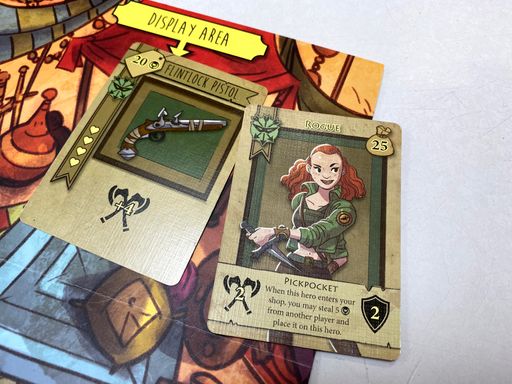
“One flintlock pistol, please!”
But alas, it’s just a display model. She is resigned to buy what’s actually on offer. So she does, and leaves, looking less like a dangerous adventurer and more like she’s been kitted out for back-to-school.
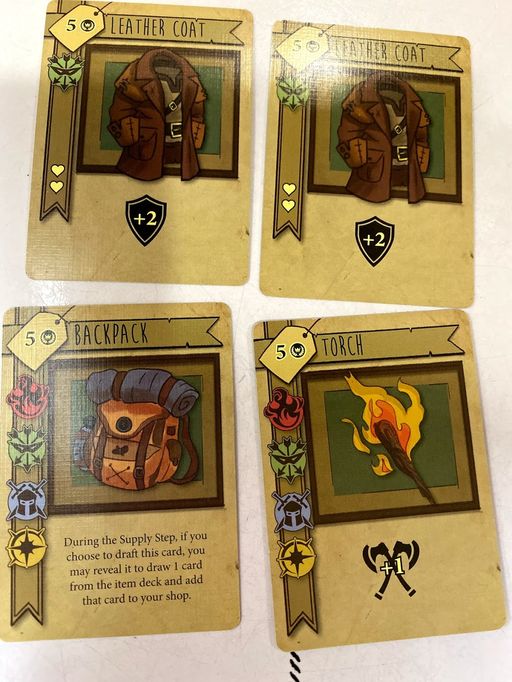
“And an extra coat in case it gets cold.”
I believe that in that case, at least, she survived the round. Those Leather Coats are pretty tough.
Telling Stories
Here are the mechanics for the shopping part of each round:
- Players draft item cards by picking one from their hand and passing the rest (similar to Sushi Go! or 7 Wonders)
- Players secretly choose a card (or cards) from their hand to be in their display, then reveal them at the same time
- Whoever’s display has the most heart icons gets first pick of the heroes, and then the next most hearts, and so on.
- Players trade the cards in their hand for the gold that’s on the heroes.
There’s a lot of simultaneous play. You pick from your hand while other players are picking. You choose your display and put it face down before everyone flips them over at once. That’s good! Everyone is involved and interested every step of the way. The only part that actually requires people to go in turns is picking the heroes.
You could do the last step simultaneously, too. Everyone has their hand of cards and their one hero, and it’s just a matter of playing them down and taking tokens. But for our first round, we went in order. Since everyone was new to the game, we thought it best to go slow so that everyone was doing it correctly.
But as we went, something fun happened. Inspired by the art and card abilities, we started telling little stories and jokes about the heroes and the cards we were giving them.2
This part of the game was so enjoyable, and we laughed so much, that we kept it up every round, even after everyone was comfortable with the rules.
I was able to get a pretty good display of Magic Lamp and Cat Familiar going, which meant that I often got first choice of heroes. On one turn, I picked the Nobleman who — and again, brilliant card ability and theme combination — has not actually developed any talent or skill on their own, but is rich and will literally buy anything.
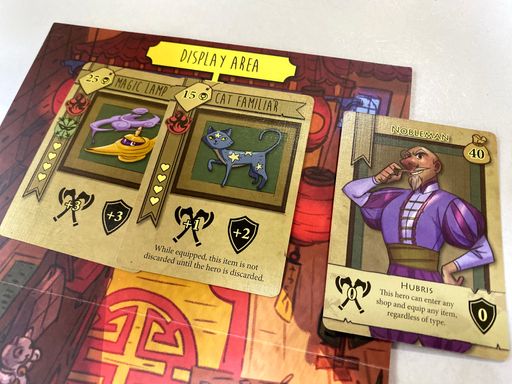
“This shop has wares that meet my standards.”
I described to the table how I welcomed him to my shop and, seeing how he was new to adventuring, gave him the most important piece of advice that would undoubtedly ensure his success in the dungeon: dress in layers
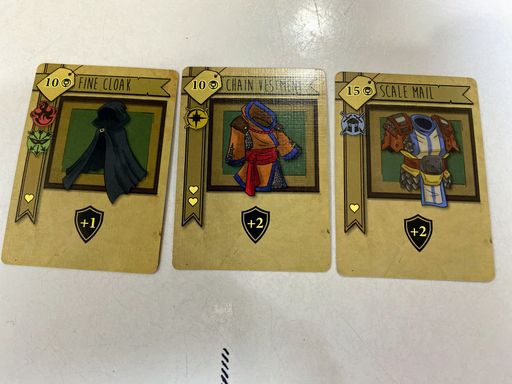
“All of the most lauded heroes know that this is the most important thing.”
And seeing how he still had five gold left after that, my trusty Sales Clerk was able to give him a wonderful, 50%-off deal on a very fine and very powerful potion.
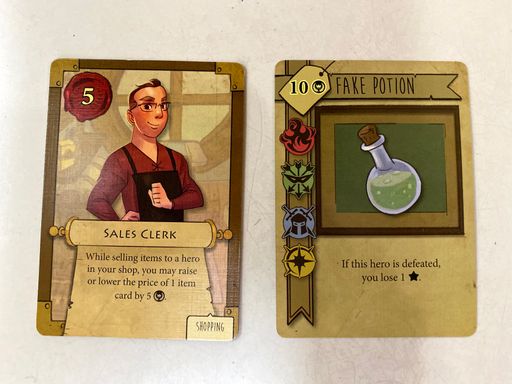
“If things get bad, just drink this and you’ll be fine. Trust me.”
In my defense, there was a chance, when the random adventure cards were flipped, that he would get a defense bonus such that he wouldn’t die. That didn’t happen. I did lose some reputation when everyone realized the potion was a fake, so it was sad for both of us, honestly.
Was this the best strategic move? I don’t know and couldn’t care less. It was funny to create this situation. I even had a running gag of selling a variety of dodgy potions. We all loved it.
Conclusion
We had a blast. With 6 players, and taking our time entertaining each other, it did creep up to about and hour-and-a-half, which would have been too long if we weren’t all so engaged.
Bargain Quest excels by including a wide variety of items and characters. Some are really good, which is neat, and some are really bad, which is funny. There’s enough game there that it’s interesting even on a mechanical level, but the art and theme and stories come together to make it something really special.
Among other things, the video’s description of your friends choosing a shop they like and then being surprised and delighted when they find out it opens up was our experience to a T.↩
Every hero card has unique art, by the way. Even though there are several “Rogue,” “Fighter,” &c. cards in the deck, they all look different, so they feel like individual people. The characters are diverse, as well. It’s truly lovely.↩